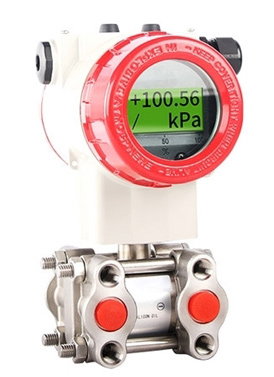What is a Differential Pressure Sensor
A differential pressure sensor is also called differential pressure transducer. It is a sensor used to measure the difference between two pressures. It is usually used to measure the differential pressure between the front and rear ends of a device or component as well as the differential pressure between different medium in the same process. Its outer casing is made of stainless steel or aluminum alloy. The connecting thread on the pressure tap is NPT1/2. The thread of the output cable connection hole is M20*1.5. Differential pressure sensors are widely used in the production process control such as electric power, coal, spinning cotton boxes, dust removal equipment and other industries.

The differential pressure sensor through structural design or installation according to the regulation, converts the change of pressure difference between different medium into the change of the built-in pressure sensitive component in the sensor. Then it modulate or process the weak output signal which produced by the deformation of pressure sensitive components through analog to digital conversion and chip operation to output an analog signal or a digital signal.
When the measured pressures are inconsistent, the measuring diaphragm will be displaced, and the displacement is proportional to the pressure difference, so the capacitance on both sides will be different. Through the oscillation and demodulation steps, the displacement is converted into a signal proportional to the pressure. Then modulate the signal to obtain a modulated current, and the A/D converter converts the current of the demodulator into a digital signal whose value is used by the microprocessor to determine the input pressure value. The microprocessor controls the operation of the sensor. In addition, it also performs calculations such as sensor linearization, reset measurement range, engineering unit scaling, damping, square root, sensor trimming, etc. as well as diagnostics and digital communications.
The differential pressure sensor measures the differential pressure. The differential pressure refers to the difference between the two measured pressures acting on either side of the sensor. Any measurement requires a comparison of the pressures on the two pressure ports on the differential pressure sensor.
In general, what we call a pressure sensor is a sensor that cannot measure the pressure difference and it can only measure the one pressure value. One end of the pressure sensor connect to the measured medium, and the other end connect to atmospheric pressure or a sealed vacuum pressure. It can only measure a certain pressure relative to atmospheric pressure or relative to vacuum. It cannot measure the pressure difference between two different pressures.
2. The measured specifications of the differential pressure sensor and pressure sensor are different
The differential pressure sensor measures the relative pressure, that is, the pressure difference at different parts of the same equipment system, or the pressure difference of different medium. The pressure sensor measures the absolute or gauge pressure of a location or a medium.
3. The interfaces of the differential pressure sensor and the pressure sensor are different
The differential pressure sensor has two input ports for connecting two measuring points. The pressure sensor has only one connection port.

- Differential pressure sensor working principle
The differential pressure sensor through structural design or installation according to the regulation, converts the change of pressure difference between different medium into the change of the built-in pressure sensitive component in the sensor. Then it modulate or process the weak output signal which produced by the deformation of pressure sensitive components through analog to digital conversion and chip operation to output an analog signal or a digital signal.
When the measured pressures are inconsistent, the measuring diaphragm will be displaced, and the displacement is proportional to the pressure difference, so the capacitance on both sides will be different. Through the oscillation and demodulation steps, the displacement is converted into a signal proportional to the pressure. Then modulate the signal to obtain a modulated current, and the A/D converter converts the current of the demodulator into a digital signal whose value is used by the microprocessor to determine the input pressure value. The microprocessor controls the operation of the sensor. In addition, it also performs calculations such as sensor linearization, reset measurement range, engineering unit scaling, damping, square root, sensor trimming, etc. as well as diagnostics and digital communications.
- The difference between differential pressure sensor and pressure sensor
The differential pressure sensor measures the differential pressure. The differential pressure refers to the difference between the two measured pressures acting on either side of the sensor. Any measurement requires a comparison of the pressures on the two pressure ports on the differential pressure sensor.
In general, what we call a pressure sensor is a sensor that cannot measure the pressure difference and it can only measure the one pressure value. One end of the pressure sensor connect to the measured medium, and the other end connect to atmospheric pressure or a sealed vacuum pressure. It can only measure a certain pressure relative to atmospheric pressure or relative to vacuum. It cannot measure the pressure difference between two different pressures.
2. The measured specifications of the differential pressure sensor and pressure sensor are different
The differential pressure sensor measures the relative pressure, that is, the pressure difference at different parts of the same equipment system, or the pressure difference of different medium. The pressure sensor measures the absolute or gauge pressure of a location or a medium.
3. The interfaces of the differential pressure sensor and the pressure sensor are different
The differential pressure sensor has two input ports for connecting two measuring points. The pressure sensor has only one connection port.

